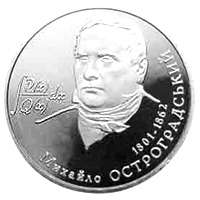Mikhail Ostrogradsky
| Mikhail Ostrogradsky | |
|---|---|
 Mikhail Vasilyevich Ostrogradsky | |
| Born |
September 24, 1801 Pashenivka, (Ukraine, Russian Empire) |
| Died |
January 1, 1862 (aged 60) Poltava |
| Citizenship | Russian Empire |
| Fields | Mathematics |
| Alma mater |
University of Kharkiv, University of Paris |
| Known for |
Ostrogradsky instability, Divergence theorem |
Mikhail Vasilyevich Ostrogradsky (transcribed also Ostrohradskyy, Ostrogradskii, Ostrogradskiĭ) (Russian: Михаил Васильевич Остроградский, Ukrainian: Михайло Васильович Остроградський, September 24, 1801 – January 1, 1862) was a Ukrainian[1][2] mathematician, mechanician and physicist in the Russian Empire. Ostrogradsky is considered to be a disciple of Leonhard Euler and one of the leading mathematicians of Imperial Russia.
Life
Ostrogradsky was born on September 24, 1801 in the village of Pashenivka (at the time in the Poltava Governorate, Russian Empire, today in Poltava Oblast, Ukraine). From 1816 to 1820, he studied under Timofei Osipovsky (1765–1832) and graduated from the University of Kharkiv. When Osipovsky was suspended on religious grounds in 1820, Ostrogradsky refused to be examined and he never received his Ph.D. degree. From 1822 to 1826, he studied at the Sorbonne and at the Collège de France in Paris, France. In 1828, he returned to the Russian Empire and settled in Saint Petersburg, where he was elected a member of the Academy of Sciences. He also became a professor of the Main military engineering School of the Russian Empire.
Ostrogradsky died in Poltava in 1862, aged 60. The Kremenchuk Mykhailo Ostrohradskyi National University in Kremenchuk, Poltava oblast, as well as Ostrogradsky street in Poltava, are named after him.
Work

He worked mainly in the mathematical fields of calculus of variations, integration of algebraic functions, number theory, algebra, geometry, probability theory and in the fields of applied mathematics, mathematical physics and classical mechanics. In the latter, his key contributions are in the motion of an elastic body and the development of methods for integration of the equations of dynamics and fluid power, following up on the works of Euler, Joseph Louis Lagrange, Siméon Denis Poisson and Augustin Louis Cauchy.
In Russia, his work in these fields was continued by Nikolay Dmitrievich Brashman (1796–1866), August Yulevich Davidov (1823–1885) and especially by Nikolai Yegorovich Zhukovsky (1847–1921).
Ostrogradsky did not appreciate the work on non-Euclidean geometry of Nikolai Lobachevsky from 1823 and he rejected it, when it was submitted for publication in the Saint Petersburg Academy of Sciences.
Divergence theorem
In 1826, Ostrogradsky gave the first general proof of the divergence theorem, which was discovered by Lagrange in 1762.[3]
Ostrogradsky's equation
.
Ostrogradsky's integration method
His method for integrating rational functions[4] is well known. First, we separate the rational part of the integral of a fractional rational function, the sum of the rational part (algebraic fraction) and the transcendental part (with the logarithm and the arctangent). Second, we determine the rational part without integrating it and we assign a given integral in Ostrogradsky's form:
where are known polynomials of degrees p, s, y respectively, is a known polynomial of degree not greater than , and are unknown polynomials of degrees not greater than and respectively.
Third, is the greatest common divisor of and . Fourth, the denominator of the remaining integral can be calculated from the equation .
See also
- Green's theorem (1827)
- Green–Ostrogradsky equation (1828)
- Hamilton–Ostrogradsky (variational) principle
- Ostrogradsky formalism
- Einstein–Ostrogradsky–Dirac Hamiltonian
- Horowitz–Ostrogradsky method
- Jacobi–Ostrogradsky coordinates
- Ostrogradsky instability
Notes
References
- Ostrogradsky, M. (1845a), "De l'intégration des fractions rationnelles", Bulletin de la classe physico-mathématique de l’Académie Impériale des Sciences de Saint-Pétersbourg, 4: 145–167.
- Ostrogradsky, M. (1845b), "De l'intégration des fractions rationnelles (fin)", Bulletin de la classe physico-mathématique de l’Académie Impériale des Sciences de Saint-Pétersbourg, 4: 286–300.
- Woodard, R.P. (9 August 2015). "The Theorem of Ostrogradsky". arXiv:1506.02210
 .
.
External links
- O'Connor, John J.; Robertson, Edmund F., "Mikhail Ostrogradsky", MacTutor History of Mathematics archive, University of St Andrews.
- Woodard, R.P. (9 Aug 2015). "The Theorem of Ostrogradsky". arXiv:1506.02210
 .
.